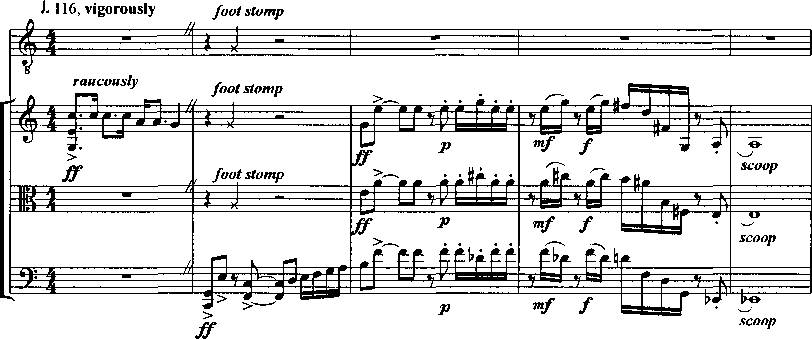43
Example 1.16: Cajun Set, Third mvt., mm. 1-5

There are several interesting features in this opening call and response that continue
throughout the movement. The call, marked “raucously,” is paired with a response by the
violin, viola and cello much longer than the one found in the original Joe Ferail. This
four-measure excerpt has several Cajun-Style features including a unison foot stomp and
a scoop into the last note, suggesting the less refined, more raucous manner of Cajun
fiddling. However, it also has elements typical of Larsen’s style including the sudden and
extreme dynamic changes, shorter rhythmic motives, and a great deal of harmonic
chromaticism.
There is no preconceived formal structure in this movement, yet this pattern of call
and response, made up of both the Joe Férail song and original material, occurs several
times in the opening of the movement. For example, in m. 6, the entire Joe Férail song is
quoted almost directly. The only difference from the Whitfield version (other than the
atonal harmonization) is that the response is in the same octave as the call.
In m. 22 a sudden change of texture and motives signals a new section. The
More intriguing information
1. DURABLE CONSUMPTION AS A STATUS GOOD: A STUDY OF NEOCLASSICAL CASES2. Are Japanese bureaucrats politically stronger than farmers?: The political economy of Japan's rice set-aside program
3. Higher education funding reforms in England: the distributional effects and the shifting balance of costs
4. The InnoRegio-program: a new way to promote regional innovation networks - empirical results of the complementary research -
5. Individual tradable permit market and traffic congestion: An experimental study
6. DETERMINANTS OF FOOD AWAY FROM HOME AMONG AFRICAN-AMERICANS
7. The name is absent
8. Self-Help Groups and Income Generation in the Informal Settlements of Nairobi
9. An alternative way to model merit good arguments
10. A Classical Probabilistic Computer Model of Consciousness